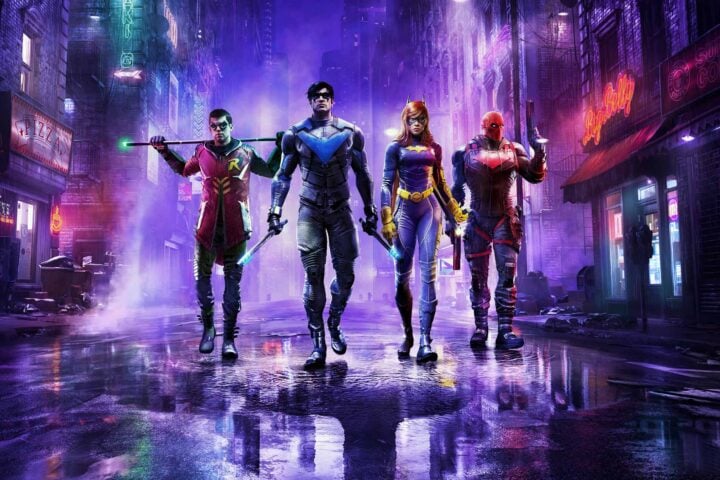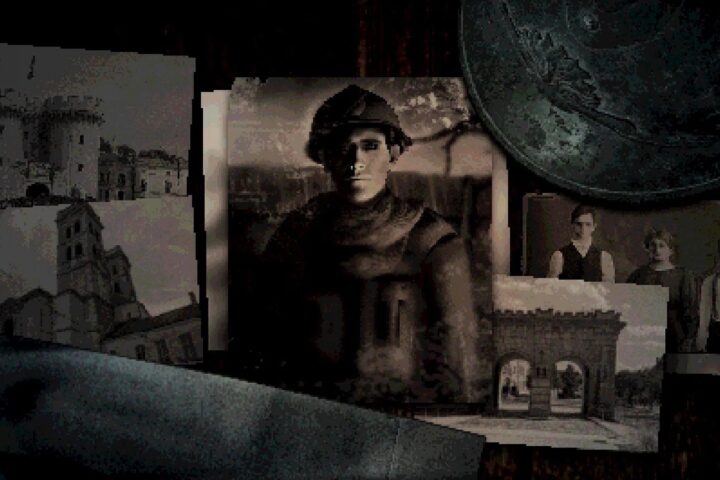While Nobody Wants to Die is set in 2329, every inch of it relishes in the past. The game opens in what appears to be a car from the 1930s, with NYPD officer James Karra, at a drive-in, watching a black-and-white movie alongside his wife, Rachel. Everything about the scene suggests that it’s set in the past—that is, up until Rachel is revealed to be a figment of James’s imagination and he opens his car door onto a stunning aerial view of Times Square. All around him, cars fly between Art Deco skyscrapers hundreds of stories high.
The game’s big sci-fi twist, which perhaps explains its obsession with the past, is that humanity has invented a mind-transferring substance called ichorite, and this has allowed people to live hundreds of years. The richest, who can afford the mandatory subscription fee (i.e., tax) for living in the world and buying a replacement “shell” from those who can’t, are functionally immortal. This classist reality permeates every inch of your investigation, which revolves around a so-called “final death” that has irreversibly destroyed one man’s ichorite.
James, who works for the Mortality Department in order to pay off the debt on his current body, arrives at the smoldering ruins of a penthouse towering above the clouds and finds someone hanging from a tree. (Possession of a tree may be the most telling indicator of wealth in the game, given that acid rain has essentially killed anything grown in soil.) To investigate, James utilizes a reconstructor, which allows him to rewind the imprinted memories at the scene. It’s a cool device for a detective, and it will be familiar to those who’ve played Remember Me or the Batman: Arkham games, but as opposed to those other games, the gameplay here is scant.
James almost exclusively interacts with harmless memories; instead of shooting criminals, he shoots pictures of holographic crime scenes, using gadgets like a UV lamp and X-ray scanner to trace things that have happened. When, in the game’s final act, he confronts other people face to face, including an active shooter, players can respond only by choosing options from a dialogue prompt. The lack of meaningful action leaves you as little more than a passive observer with little more to do than move from object to object, advancing the plot one scan at a time.
Thankfully, Nobody Wants to Die makes for a fairly enjoyable interactive movie, and gets away with its constant delving into the past because of how smartly and smoothly it uses objects to relay a chillingly convincing vision of what immortality might look like under capitalism. The game’s plot points also feed into well-worn noir tropes. For one, James is particularly hard-boiled, with 50-plus years of service under his belt, and his alcoholism is a product of the low-grade body provided to him. He’s also suffering from desynchronizing hallucinations that make him a less-than-reliable narrator, especially once his own past becomes a part of the plot.
The game gets a lot of mileage out of its crime scenes, among them an exclusive bar located on a perpetually flying zeppelin and a hedonistic “Redroom” filled with holographic orgies. Though Nobody Wants to Die very much holds players’ hands in indicating the key evidence that you have to interact with, you’re free to examine other objects that are tangential to the campaign, and the game’s writing vividly provides background on things like the “U.S. Declaration of Immortality: Immortality, Freedom, and the Pursuit of Happiness,” the existence of “familiarization” parties where you can get to know an old friend’s new body, and the rare kink of self-snuff (the act of buying a body for the pleasure of being killed in it).
As befits a game about reusing bodies, nothing in Nobody Wants to Die seems thrown away. Indeed, even its metaphoric noir-speak serves to deepen the rich visuals. The suggestion that the case you’re investigating “smells worse than a two-month-old corpse in a storm drain” enhances your understanding of just how awful conditions are below said drain. Elsewhere, the warning that “Mount Olympus comes with a pocket Hades” accents the differences between the nightmarish heights of Manhattan, where the windows peek out above the acid-rain clouds, and Liberty Island, where the famed statue’s now-severed head rests buried in a heap of makeshift slums. James’s deteriorating synchronization with his latest body also leads to some terrific hallucinations and visual glitches, driving home the psychic cost of living for so long.
Nobody Wants to Die struggles to reach a satisfying conclusion, which is, perhaps fittingly, indicated by its very title. There’s a serial killer, conspiracy theory, James’s traumatic past, his current partner’s illicit body-rental surrogacy, and a class riot. The game’s body-swapping shenanigans mashes several of those plots into a confusing showdown that may leave you unsure as to who you’re even confronting. The ending that my choices led to—the point at which you’d most want to do a reconstruction—was abrupt and disappointing, leaving the fate of many characters in question. How unfortunate, then, that out of all the places in which the game allows you to rewind time and relive past events, your save file isn’t one of them.
We didn’t receive a response from the game’s publicist to our request for review code. This game was reviewed with code purchased by the reviewer.
Since 2001, we've brought you uncompromising, candid takes on the world of film, music, television, video games, theater, and more. Independently owned and operated publications like Slant have been hit hard in recent years, but we’re committed to keeping our content free and accessible—meaning no paywalls or fees.
If you like what we do, please consider subscribing to our Patreon or making a donation.




